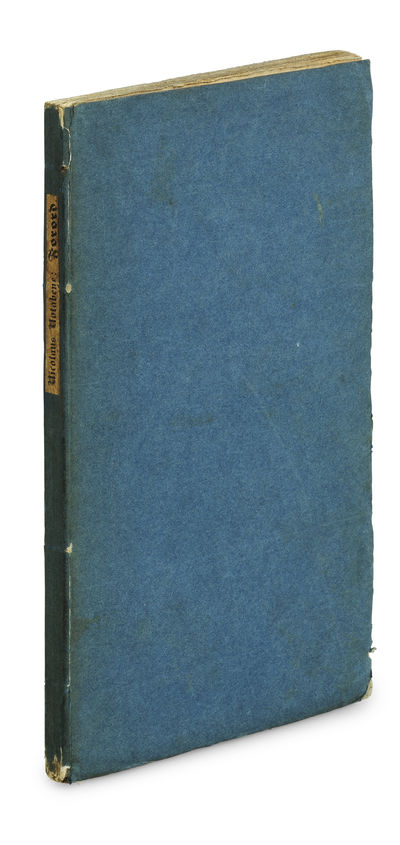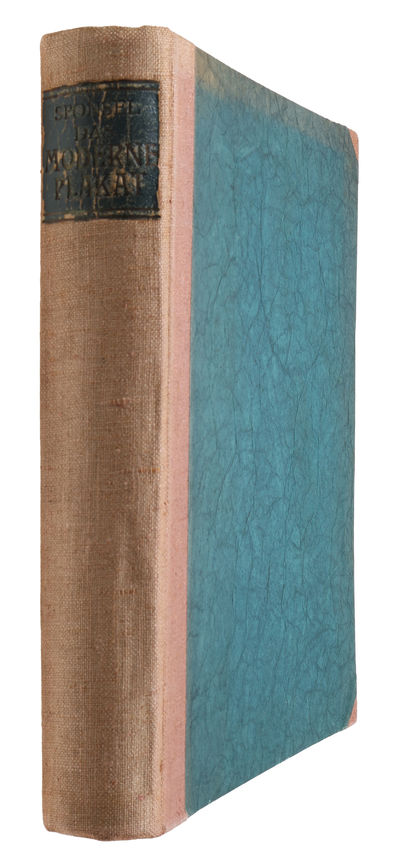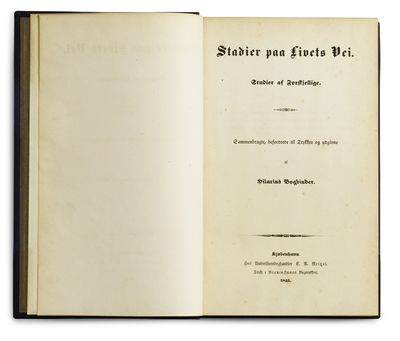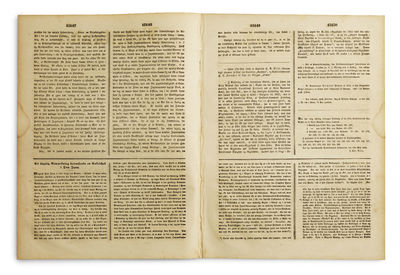TRUSLEW, N. (& ECKERSBERG).
En Samling af Skibe i næsten alle mulige Stillinger i Söen. Udført i Kobber [i.e. A Collection of Ships in almost every Possible Position in the Sea. Executed in Copper]. - [THE CREATION OF THE DANISH SEASCAPE PAINTING]
Herman H. J. Lynge & Søn A/S
lyn60286
Kjöbenhavn, 1805 (-ca. 1807). Queer-folio (binding measuring 25,2 x 32 cm). Bound in a later (ca. 1920'ies), elegant brown full calf binding with gilt ornamentations to spine. Boards with gilt line-frames, gilt rosettes as those on spine and larger gilt corner-decorations. All edges of boards gilt and inner gilt dentelles. Front board with gilt title in the middle. Neatly rebacked. Minor wear to back board and a few smaller stains to front board and spine. Overall very nice. Bound with one of the very scarce printed title-labels. This is for the third issue, dated 1805 (the collection was issued in six issues, all dated between 1805 and 1806. They appeared in blue wrappers with printed title-labels, of which the last number in the year and the number of the issue were left blank to be added in hand, as they are here. Only a few examples of these title-labels have been preserved). All 36 engraved and hand-coloured plates (all measuring 16 x 21 cm) mounted on leaves of thick cardboard-like paper (measuring 24,5 x 31 cm). All images with original handwritten description in Danish underneath. Occasional brownspotting, but overall in very nice condition.
Exceedingly scarce collection of all 36 plates that were issued of Truslew’s spectacular “Ships in the Sea”, this being one of three complete copies known. Only two complete copies exist in public institutions (Handels- og Søfartsmuseet at Kronborg and the Danish Royal Collection of Graphic Art), and this is the only known complete copy on private hands. The 36 highly interesting plates that constitute this rare work occupy a central role in the history of Danish art, culture, and in the history of wartime. It is with this work that the tradition of Danish marine art is founded and it is inextricably linked with the name of one of the greatest Danish artists of all time: C.W. Eckersberg (known as “the father of Danish seascape painting”). It is generally accepted that Eckersberg with all likelihood drew the illustrations for Truslews etchings. “Ahead of his major travel to Paris and Rome in 1810-16, he (i.e. Eckersberg) had executed a number of ship portraits that were issued by N. Truslew in 1805 under the title “En samling skibe i næsten alle mulige stillinger i søen 1-6 Hæfte”. It is (a collection of) 36 coloured aquatints that could be engraved after the drawings of Eckersberg”. (Own translation from Danish, from “Den Danske udvikling of marinemaleriet. C.W. Eckersbergs arbejder af maritime karakter”, pp. 10-11). Not much is known about the amateur artist Niels Truslew, who was born in 1762 and was employed for decades in the office of the commercial house of the merchant Niels Ryberg. We know for certain, however, that Eckersberg and Truslew knew each other, and we know that for a while they worked together. It has also been proved beyond doubt that one of Eckersberg’s early watercolours from 1804 is the model for plate nr. V in the present collection. “[T]he role of the young Eckersberg, who became his generation’s most prominent painter, in the creation of the engravings is of considerably (sic) interest. Though it is true that it is not known with certainty just how much Eckersberg was involved, the series is evidence of a Danish background for the famous seascapes which Eckersberg first began to paint in the 1820‘s. In the period after he had done his early watercolour, he had been in Paris as a student of David, and it has been thought that the source of inspiration for Danish sea painting should therefore be found in the south. Truslew’s engravings show, however, that there was a native background for Eckersberg’s seascapes which, at the same time, of course, must be seen in the context of a larger European tradition.” (Møller, Lorentzen & Møller: Niels Truslew – Skibe I Søen 1805. 1979. Pp. 121-22). Apart from its obvious artistic importance, this scarce collection sheds light on a highly important period in Danish history, right between the Battle of Copenhagen (1801) - between Admiral Nelson’s squadrons and the anchored Danish ship blocks – and the bombardment of Copenhagen (1807) by the British. It is a period in which Danish maritime trade blossomed anew under the shelter of neutrality, and a period that saw a dramatic increase in popular interest in maritime subjects. The work is novel in several respects and is not merely a collection of ship portraits as such. It is also not a catalogue of ship types, as one finds in the 18th century, nor a collection meant for students. Truslew portrays the ships in action, and the illustrations are of one or more ships in function, in specific situations. Sometimes they will be exposed to the raging of the elements (it is probably not a coincidence that it is an English ship that is hit by lightening!), but most of them are seen in undramatic, everyday situations. The choice of ships is highly interesting, as it includes both English, American, Russian, French, Dutch, and Swedish ships, as well as Danish. And seeing that the interest lies in portraying contemporary ships, not historical ones, it becomes and important historical source. The American schooner, for instance, alludes to the West Indies. Sweden, France, and Russia are represented by warships, whereas there is not a single English warship. What is also unusual for this type of illustrations of the period, in both Denmark and abroad, is Truslew’s ability to create space around the ships, to put them in perspective and create an overall effect of space. These 36 plates are extremely rare and as mentioned, only two complete copies exist in public institutions. These two known copies vary from each other, however. The plates of the copy at Handels- og Søfartsmuseet has both German and Danish text, and the plates are numbered in the plates. That of the Royal Collection of Graphic Art has the Danish handwritten text under the plates and no numbering, as our copy. It is that copy that is used for the 1979-publication, “Truslew – Skibe i Søen”, which reproduces all of the plates. Our copy confirms exactly to that, with a few small variations: The handwritten text on plate VIII in our copy says “En Brig…” in stead of “En dansk Brig” The colouring of the American flag on plate XXXII varies a bit, as the red stripes are much clearer in our copy The handwritten text on plate XXXVI in our copy reads “anker” in stead of “ankeret”.
Exceedingly scarce collection of all 36 plates that were issued of Truslew’s spectacular “Ships in the Sea”, this being one of three complete copies known. Only two complete copies exist in public institutions (Handels- og Søfartsmuseet at Kronborg and the Danish Royal Collection of Graphic Art), and this is the only known complete copy on private hands. The 36 highly interesting plates that constitute this rare work occupy a central role in the history of Danish art, culture, and in the history of wartime. It is with this work that the tradition of Danish marine art is founded and it is inextricably linked with the name of one of the greatest Danish artists of all time: C.W. Eckersberg (known as “the father of Danish seascape painting”). It is generally accepted that Eckersberg with all likelihood drew the illustrations for Truslews etchings. “Ahead of his major travel to Paris and Rome in 1810-16, he (i.e. Eckersberg) had executed a number of ship portraits that were issued by N. Truslew in 1805 under the title “En samling skibe i næsten alle mulige stillinger i søen 1-6 Hæfte”. It is (a collection of) 36 coloured aquatints that could be engraved after the drawings of Eckersberg”. (Own translation from Danish, from “Den Danske udvikling of marinemaleriet. C.W. Eckersbergs arbejder af maritime karakter”, pp. 10-11). Not much is known about the amateur artist Niels Truslew, who was born in 1762 and was employed for decades in the office of the commercial house of the merchant Niels Ryberg. We know for certain, however, that Eckersberg and Truslew knew each other, and we know that for a while they worked together. It has also been proved beyond doubt that one of Eckersberg’s early watercolours from 1804 is the model for plate nr. V in the present collection. “[T]he role of the young Eckersberg, who became his generation’s most prominent painter, in the creation of the engravings is of considerably (sic) interest. Though it is true that it is not known with certainty just how much Eckersberg was involved, the series is evidence of a Danish background for the famous seascapes which Eckersberg first began to paint in the 1820‘s. In the period after he had done his early watercolour, he had been in Paris as a student of David, and it has been thought that the source of inspiration for Danish sea painting should therefore be found in the south. Truslew’s engravings show, however, that there was a native background for Eckersberg’s seascapes which, at the same time, of course, must be seen in the context of a larger European tradition.” (Møller, Lorentzen & Møller: Niels Truslew – Skibe I Søen 1805. 1979. Pp. 121-22). Apart from its obvious artistic importance, this scarce collection sheds light on a highly important period in Danish history, right between the Battle of Copenhagen (1801) - between Admiral Nelson’s squadrons and the anchored Danish ship blocks – and the bombardment of Copenhagen (1807) by the British. It is a period in which Danish maritime trade blossomed anew under the shelter of neutrality, and a period that saw a dramatic increase in popular interest in maritime subjects. The work is novel in several respects and is not merely a collection of ship portraits as such. It is also not a catalogue of ship types, as one finds in the 18th century, nor a collection meant for students. Truslew portrays the ships in action, and the illustrations are of one or more ships in function, in specific situations. Sometimes they will be exposed to the raging of the elements (it is probably not a coincidence that it is an English ship that is hit by lightening!), but most of them are seen in undramatic, everyday situations. The choice of ships is highly interesting, as it includes both English, American, Russian, French, Dutch, and Swedish ships, as well as Danish. And seeing that the interest lies in portraying contemporary ships, not historical ones, it becomes and important historical source. The American schooner, for instance, alludes to the West Indies. Sweden, France, and Russia are represented by warships, whereas there is not a single English warship. What is also unusual for this type of illustrations of the period, in both Denmark and abroad, is Truslew’s ability to create space around the ships, to put them in perspective and create an overall effect of space. These 36 plates are extremely rare and as mentioned, only two complete copies exist in public institutions. These two known copies vary from each other, however. The plates of the copy at Handels- og Søfartsmuseet has both German and Danish text, and the plates are numbered in the plates. That of the Royal Collection of Graphic Art has the Danish handwritten text under the plates and no numbering, as our copy. It is that copy that is used for the 1979-publication, “Truslew – Skibe i Søen”, which reproduces all of the plates. Our copy confirms exactly to that, with a few small variations: The handwritten text on plate VIII in our copy says “En Brig…” in stead of “En dansk Brig” The colouring of the American flag on plate XXXII varies a bit, as the red stripes are much clearer in our copy The handwritten text on plate XXXVI in our copy reads “anker” in stead of “ankeret”.
Adress:
Silkegade 11
DK-1113 Copenhagen Denmark
Telefon:
CVR/VAT:
DK 16 89 50 16
E-post:
Webb:
![En Samling af Skibe i næsten alle mulige Stillinger i Söen. Udført i Kobber [i.e. A Collection of Ships in almost every Possible Position in the Sea. Executed in Copper]. - [THE CREATION OF THE DANISH SEASCAPE PAINTING] (photo 1)](https://d3525k1ryd2155.cloudfront.net/h/782/991/1527991782.0.l.0.jpg)
![En Samling af Skibe i næsten alle mulige Stillinger i Söen. Udført i Kobber [i.e. A Collection of Ships in almost every Possible Position in the Sea. Executed in Copper]. - [THE CREATION OF THE DANISH SEASCAPE PAINTING] (photo 2)](https://d3525k1ryd2155.cloudfront.net/h/782/991/1527991782.1.l.0.jpg)
![En Samling af Skibe i næsten alle mulige Stillinger i Söen. Udført i Kobber [i.e. A Collection of Ships in almost every Possible Position in the Sea. Executed in Copper]. - [THE CREATION OF THE DANISH SEASCAPE PAINTING] (photo 3)](https://d3525k1ryd2155.cloudfront.net/h/782/991/1527991782.2.l.0.jpg)
![En Samling af Skibe i næsten alle mulige Stillinger i Söen. Udført i Kobber [i.e. A Collection of Ships in almost every Possible Position in the Sea. Executed in Copper]. - [THE CREATION OF THE DANISH SEASCAPE PAINTING] (photo 4)](https://d3525k1ryd2155.cloudfront.net/h/782/991/1527991782.3.l.0.jpg)
![En Samling af Skibe i næsten alle mulige Stillinger i Söen. Udført i Kobber [i.e. A Collection of Ships in almost every Possible Position in the Sea. Executed in Copper]. - [THE CREATION OF THE DANISH SEASCAPE PAINTING] (photo 5)](https://d3525k1ryd2155.cloudfront.net/h/782/991/1527991782.4.l.0.jpg)
![En Samling af Skibe i næsten alle mulige Stillinger i Söen. Udført i Kobber [i.e. A Collection of Ships in almost every Possible Position in the Sea. Executed in Copper]. - [THE CREATION OF THE DANISH SEASCAPE PAINTING] (photo 6)](https://d3525k1ryd2155.cloudfront.net/h/782/991/1527991782.5.l.0.jpg)
![En Samling af Skibe i næsten alle mulige Stillinger i Söen. Udført i Kobber [i.e. A Collection of Ships in almost every Possible Position in the Sea. Executed in Copper]. - [THE CREATION OF THE DANISH SEASCAPE PAINTING] (photo 7)](https://d3525k1ryd2155.cloudfront.net/h/782/991/1527991782.6.l.0.jpg)
![En Samling af Skibe i næsten alle mulige Stillinger i Söen. Udført i Kobber [i.e. A Collection of Ships in almost every Possible Position in the Sea. Executed in Copper]. - [THE CREATION OF THE DANISH SEASCAPE PAINTING] (photo 8)](https://d3525k1ryd2155.cloudfront.net/h/782/991/1527991782.7.l.0.jpg)
![En Samling af Skibe i næsten alle mulige Stillinger i Söen. Udført i Kobber [i.e. A Collection of Ships in almost every Possible Position in the Sea. Executed in Copper]. - [THE CREATION OF THE DANISH SEASCAPE PAINTING] (photo 9)](https://d3525k1ryd2155.cloudfront.net/h/782/991/1527991782.8.l.0.jpg)
![En Samling af Skibe i næsten alle mulige Stillinger i Söen. Udført i Kobber [i.e. A Collection of Ships in almost every Possible Position in the Sea. Executed in Copper]. - [THE CREATION OF THE DANISH SEASCAPE PAINTING] (photo 10)](https://d3525k1ryd2155.cloudfront.net/h/782/991/1527991782.9.l.0.jpg)
![En Samling af Skibe i næsten alle mulige Stillinger i Söen. Udført i Kobber [i.e. A Collection of Ships in almost every Possible Position in the Sea. Executed in Copper]. - [THE CREATION OF THE DANISH SEASCAPE PAINTING] (photo 11)](https://d3525k1ryd2155.cloudfront.net/h/782/991/1527991782.10.l.0.jpg)
![En Samling af Skibe i næsten alle mulige Stillinger i Söen. Udført i Kobber [i.e. A Collection of Ships in almost every Possible Position in the Sea. Executed in Copper]. - [THE CREATION OF THE DANISH SEASCAPE PAINTING] (photo 12)](https://d3525k1ryd2155.cloudfront.net/h/782/991/1527991782.11.l.0.jpg)





